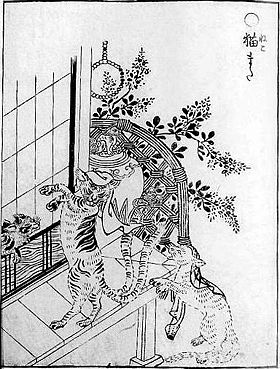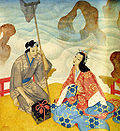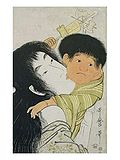- Bakeneko
-
 Nekomata walking on its hind legs, illustrated by Toriyama Sekien.
Nekomata walking on its hind legs, illustrated by Toriyama Sekien.
A bakeneko (化け猫, "monster-cat") is, in Japanese folklore, a cat with supernatural abilities akin to those of the fox or raccoon dog. A cat may become a bakeneko in a number of ways: it may reach a certain age, be kept for a certain number of years, grow to a certain size, or be allowed to keep a long tail. In the last case, the tail forks in two and the bakeneko is then called a nekomata (猫又, or 猫股 "forked-cat"). This superstition may have some connection to the breeding of the Japanese Bobtail.
A bakeneko will haunt any household it is kept in, creating ghostly fireballs, menacing sleepers, walking on its hind legs, changing its shape into that of a human, and even devouring its own mistress in order to shapeshift and take her place. When it is finally killed, its body may be as much as five feet in length. It also poses a danger if allowed into a room with a fresh corpse; a cat is believed to be capable of reanimating a body by jumping over it.
Contents
Bakeneko
In Japanese folklore, any cat that lives over one hundred years old, reaches one kan (3.75 kg or 8.25 lbs) in weight or is allowed to keep a long tail can become a bake-neko (化け猫) or cat monster (Addis 2001). A bake-neko is a cat that gains paranormal powers after certain circumstances. They also have the ability to eat (bigger or smaller) anything in its way, no matter what it is. Poison is its main food, for example, a certain type of snake (unknown to humans). It is rare to see people with a 'bake-neko' though some people have been known to see it. The breeding of the Japanese Bobtail may have some connection with this superstition. After a bake-neko tail grows long enough it forks into two tails, then the bake-neko is no longer called a bake-neko, but a neko-mata. Other forms of bake-neko are Maneki-neko (Addis 2001). Most of the stories about the bake-neko are told orally in Japan.
History
In the early 17th century the Japanese used cats to kill off the rats and mice that were threatening the silkworms. During this time it was illegal to buy or sell cats. Most of the cats in Japan were set free to roam around the cities. Stories about these street cats became legends over time. There are many stories about the supernatural abilities of the bake-neko: talking, walking on their two rear legs, shapeshifting, flying, killing people, and even resurrecting the dead. Because of the stories about the bake-neko some Japanese people may have cut their cat’s tail off to stop them from becoming a bake-neko. Cats that were caught drinking lamp oil were also considered to be bake-neko. Cats may have regularly been drinking lamp oil as it was based on fish oil.
Legends
There are many legends about the bake-neko. One in particular may have given birth to the Japanese Bobtail. As the legend goes, a cat was warming itself near the fire and set its tail on fire. The long-tail cat then ran through the town burning many buildings to the ground. For retribution the Emperor decreed that all cats should have their tails cut off.
Another famous bake-neko story is about a man named Takasu Genbei, whose mother’s personality changed completely after his pet cat went missing for many years. His mother avoided the company of friends and family and would take her meals alone in her room. When the family peeked in on her they saw a cat-like monster in the mother's clothes, chewing on animal carcasses. Takasu, still skeptical, slew what looked like his mother and after one day his mother's body turned back into his pet cat that had been missing.
Not all bake-neko are bad; in some stories they are faithful and good-hearted to their owners; three stories in particular tie benevolent bakeneko to the legend of the famous maneki neko, or the "beckoning cat". One such story is about a bake-neko named Tama. Tama's owner was a very poor priest who lived in a rundown temple in Setagaya, west of Tokyo. The priest would tell Tama, “I’m keeping you in spite of my poverty, so couldn’t you do something for this temple?” One day the lord of the Hikone district, Naotaka, was standing under a tree to avoid the rain. Naotaka became aware of a cat beckoning him to a temple gate. As he began to walk the tree was struck by lightning[citation needed]. Afterwards, Naotaka became friends with the temple priest, and donated lots of money to have the run-down temple rebuilt. When Tama died, the priest built a grave for the cat; eventually, a shrine was built within the temple grounds dedicated to the "beckoning cat". Gotokuji temple still stands today; the nearby Gōtokuji Station on the Odakyu Line was named after it.
Yet another story[citation needed] tells of an poor old couple who kept a small cat. Since they were unable to bear children, they came to treat the cat as their child. After the old man fell sick, a mysterious woman appeared on their doorstep, claiming to be the cat and swearing she would repay their kindness. She brought the couple much wealth; in some versions they were happy just to have a daughter. One of her admirers happened to see her in her true form so she pleaded that he not tell anyone. A few weeks later he broke his promise telling a fisherman and passengers on a ship what he'd seen. A vicious storm arose and the woman appeared in the clouds overhead. She grew into a large cat and killed him.
Another story[citation needed] is about a cat owned by a high-ranking geisha. Every time she would try to go to the toilet, the cat would claw at her robes to keep her away. Because of the cat’s strange behavior, the geisha killed it. But as she began to use the toilet, the ghost of the cat killed a snake that was lurking nearby.
Sometimes the bake-neko had the power to enter someone’s dreams. There is a story about a bake-neko who entered her owner's dream to tell her to manufacture its image in clay in order to bring her wealth. Other stories tell about how a bake-neko may sometimes shape-shift into a beautiful girl, so that their owner would be able to marry them and have children.
Though the "bake-neko" has been known for other mysterious dreaming experiences, it is also known to become a human, and live a life as a human would normally. They often look just like the person they are after to kill and/or harm.
See also
- Doppelgänger
- Japanese mythology in popular culture
- Puss in boots
- Werecat
References
- Casal, U. A. (1959). "The Goblin Fox and Badger and Other Witch Animals of Japan". Folklore Studies (Asian Folklore Studies, Nanzan University) 18: 1–93. doi:10.2307/1177429. JSTOR 1177429. http://nirc.nanzan-u.ac.jp/publications/afs/pdf/a116.pdf.
- Mizuki, Shigeru (2003). Mujara 3: Kinki-hen. Japan: Soft Garage. p. 108. ISBN 4861330068.
- Mizuki, Shigeru (2003). Mujara 2: Chūbu-hen. Japan: Soft Garage. pp. 88, 117. ISBN 4-86133-005-X.
- Addis, Stephen, ed. Japanese Ghosts and Demons: Art of the Supernatural. George Braziller, 2001.
- Kiej'e, Nikolas. Japanese Grotesqueries. C. E. Tuttle Co., 1973.
- Kaii-Yōkai Denshō Database (KYDD). Online bibliographical database of supernatural folklore published by the International Research Center for Japanese Studies.
- Morgan S.H. (2000). “Bake-neko”
External links
Japanese folklore 
Folktales 
Text collections Legendary creatures Mythology in popular culture · Legendary creatures Categories:- Japanese legendary creatures
- Fictional cats
- Japanese words and phrases
- Mythological felines
Wikimedia Foundation. 2010.
